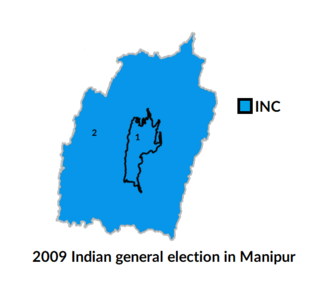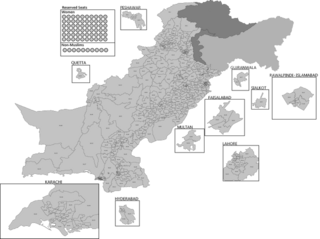
The politics of the Lao People's Democratic Republic takes place in the framework of a one-party parliamentary socialist republic. The only legal political party is the Lao People's Revolutionary Party (LPRP). The head of state is President Thongloun Sisoulith, who is also the LPRP general secretary, making him the supreme leader of Laos. The head of government is Prime Minister Sonexay Siphandone.
Norway elects its legislature on a national level. The parliament, the Storting, has 169 members elected for a four-year term by a form of proportional representation in multi-seat constituencies.
Regular elections in Croatia are mandated by the Constitution and legislation enacted by Parliament. The presidency, Parliament, county prefects and assemblies, city and town mayors, and city and municipal councils are all elective offices. Since 1990, seven presidential elections have been held. During the same period, ten parliamentary elections were also held. In addition, there were nine nationwide local elections. Croatia has also held three elections to elect members of the European Parliament following its accession to the EU on 1 July 2013.
Elections in Malaysia include elections to public office of the political entities that since 1963 have composed the federation of Malaysia. At present, elections in Malaysia exist at two levels: federal level and state level. Federal level elections are those for membership in the Dewan Rakyat, the lower house of Parliament, while state level elections are for membership in the various State Legislative Assemblies. The heads of executive branch at both the federal and state levels, the Prime Minister and Menteri Besar/Chief Ministers respectively, are indirectly elected, usually filled by a member of the majority party/coalition in the respective legislatures.
India has a parliamentary system as defined by its constitution, with power distributed between the central government and the states.

Since its establishment in 1947, Pakistan has had an asymmetric federal government and is a federal parliamentary democratic republic. At the national level, the people of Pakistan elect a bicameral legislature, the Parliament of Pakistan. The parliament consists of a lower house called the National Assembly, which is elected directly, and an upper house called the Senate, whose members are chosen by elected provincial legislators. The head of government, the Prime Minister, is elected by the majority members of the National Assembly and the head of state, the President, is elected by the Electoral College, which consists of both houses of Parliament together with the four provincial assemblies. In addition to the national parliament and the provincial assemblies, Pakistan also has more than five thousand elected local governments.
In various parliamentary systems, a returning officer is responsible for overseeing elections in one or more constituencies.

The National Assembly is the unicameral parliament of Laos. The National Assembly meets in Vientiane.

The ninth Sarawak state election was held on Saturday, 20 May 2006 with nomination day on Tuesday, 9 May 2006. The election functioned to elect 71 representatives to the Sarawak State Assembly. The eighth state assembly was dissolved by Yang di-Pertua Negeri Sarawak, Tun Abang Muhammad Salahuddin Abang Barieng by the advice of Chief Minister Abdul Taib Mahmud, on 24 April 2006.
Panachage is the name given to a procedure provided for in several open-list variants of the party-list proportional representation system. It gives voters more than one vote in the same ballot and allows them to distribute their votes between or among individual candidates from different party lists. Seats are allocated to parties based on party vote share, with the seats of a party going to the most-popular candidate(s) of that party.

Parliamentary elections were held in Laos on 4 May 1958, in order to elect an additional 21 seats to the enlarged National Assembly, the lower chamber of Parliament. The Lao Patriotic Front won the most seats, although the ruling National Progressive Party remained the largest party in the Assembly, holding 26 of the 60 seats. Voter turnout was 82%.

The 2009 Indian general election in Manipur, occurred for 2 seats in the state.

There are five types of elections in the United Kingdom: elections to the House of Commons of the United Kingdom, elections to devolved parliaments and assemblies, local elections, mayoral elections, and Police and Crime Commissioner elections. Within each of those categories, there may also be by-elections. Elections are held on Election Day, which is conventionally a Thursday, and under the provisions of the Dissolution and Calling of Parliament Act 2022 the timing of general elections can be held at the discretion of the prime minister during any five-year period. All other types of elections are held after fixed periods, though early elections to the devolved assemblies and parliaments can occur in certain situations. The five electoral systems used are: the single member plurality system (first-past-the-post), the multi-member plurality, the single transferable vote, the additional member system, and the supplementary vote.

Parliamentary elections were held in Armenia on 2 April 2017. They were the first elections after a constitutional referendum in 2015 that approved reforms for the country to become a parliamentary republic. The result was a victory for the ruling Republican Party of Armenia, which won 58 of the 105 seats in the National Assembly.
Legislative elections were held in East Bengal between 8 and 12 March 1954, the first since Pakistan became an independent country in 1947. The opposition United Front led by the Awami League and Krishak Sramik Party won a landslide victory with 223 of the 309 seats. The Muslim League Chief Minister of East Pakistan Nurul Amin was defeated in his own constituency by Khaleque Nawaz Khan by over 7,000 votes, with all the Muslim League ministers losing their seats.

Parliamentary elections were held in Laos on 20 March 2016. Voters were presented with a single list from the Lao Front for National Construction, dominated by the Communist Lao People's Revolutionary Party (LRPP). The LPRP won 144 of the 149 seats, with pro-government independents winning the remaining five.

General elections are scheduled to be held in Pakistan less than 60 days after the dissolution of the National Assembly, which is set to dissolve on 13 August 2023 upon completing its five year term, unless dissolved earlier, in which case the election shall be held within 90 days after dissolution according to the constitution. This means that the election must be held no later than 10 November 2023. The three major parties are Pakistan Tehreek-e-Insaf (PTI) led by Imran Khan, Pakistan Muslim League (N) (PML-N) led by incumbent prime minister Shehbaz Sharif and Pakistan Peoples Party (PPP) led by incumbent Foreign Minister Bilawal Bhutto Zardari.

General elections were held in the Territory of Papua and New Guinea between 19 February and 11 March 1972. They saw the election of the country's first female MP, Josephine Abaijah.

The 9th National Assembly of Laos was elected by a popular vote on 21 February 2021 to replace the 8th National Assembly. It convened its 1st Ordinary Session on 22 March 2021.

General elections were held in Papua New Guinea from 4 to 22 July 2022 to elect the members of the National Parliament for a new five-year term.










